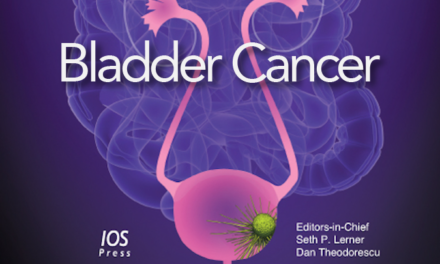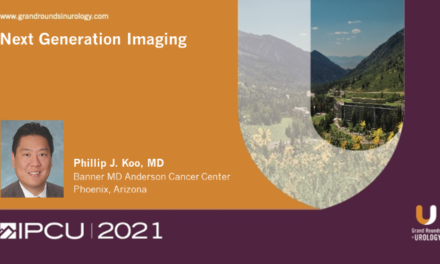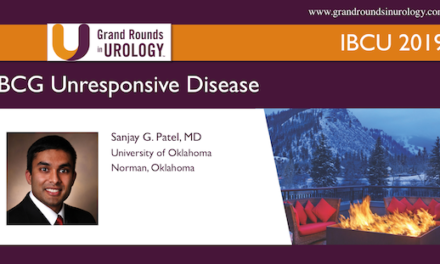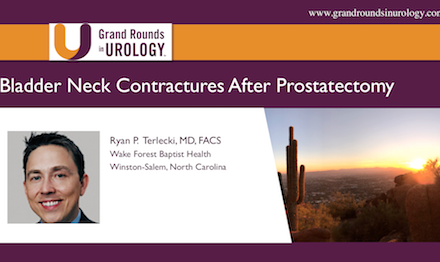Erik P. Castle, MD, presented “Perioperative Management of the Radical Cystectomy Patient” at the 26th Annual Perspectives in Urology: Point-Counterpoint, November 10, 2017 in Scottsdale, AZ
How to cite: Castle, Erik P. “Perioperative Management of the Radical Cystectomy Patient” November 10, 2017. Accessed Dec 2024. https://dev.grandroundsinurology.com/perioperative-management-radical-cystectomy-patient/
Summary:
Erik P. Castle, MD, explains approaches to improving enhanced recovery after surgery (ERAS) for non-muscle invasive bladder cancer patients who have gone through radical cystectomy and other surgeries. He emphasized the benefits of administering Alvimopan in this process.
Perioperative Management of the Radical Cystectomy Patient
Transcript:
So I know the agenda talks about Checkpoint inhibitors. Dr. Bryce, who will be following me, we recognized early on that it is really going to be overlap. We didn’t want to have anything to repetitive so we decided to come up with something very practical.
How many people here in the room do radical cystectomy? Okay, great. How many people maybe don’t do it but are involved with maybe taking care of them or managing them. So this will be just a very practical what have we evolved to in the radical cystectomy patient?
Again, no disclosures sadly.
All right, so we’re going to briefly talk about ERAS. You know, ERAS is like the hot thing. Everywhere, whether it’s colorectal surgery, general surgery, uro-gyn, GYN, onc, everybody is trying to get everybody out of the hospital as fast as possible understandably, give them the appropriate treatments, and we’re trying everything, right, IV Tylenol, tap locks, everything you can think of in the operating room to get people out of the hospital, so I’m going to talk to you about kind of what I’ve evolved to since really kind of embarking on radical cystectomy, particularly robotic radical cystectomy and just to give you some background on that I trained in open cystectomy at University of Kansas at KU. Then I went and did a minimally invasive fellowship in urinary or urethral reconstructive at Mayo Clinic in Arizona and then kind of moved on to the robot. I’m going to tell you that originally I hated the robot with a passion, and the reason was, which is hard for a lot of people to believe was that was trained as a laparoscopist, and I didn’t need a robot to help me do anything, and then like so often is the case for many surgeons, once you use the machine, you get kind of seduced by it because it makes everything easier if you are able to use it in a particular case. Then, you know, we have had an evolution of different pathways and my enthusiasm for various different things has waxed and waned, whether central corporeal diversions, whether it’s getting people out of the hospital, and I’ve really come to some observations that we’ll talk about here.
So again ERAS is the fad. What are some things that we’ve realized over the last 10 or 15 years? Well, it’s that one you don’t really need a bowel prep, and I remember in my residency especially at the VA if a patient showed up and had not done their full Nichols [phonetic] prep and taken a full bottle of Go Lightly, we would cancel the operation, just flat out cancel it. You were convinced if they missed that dose of neomycin or emycin, they were going to get an infection, and it was interesting because it goes to show you it’s kind of like the Will Rogers quote that Mike put up. Experience really is everything.
I was at a course, I was junior faculty at Tulane, and Urs Studer was giving a course, and I took a post-graduate course in taking of the cystectomy patient, particular the neo-bladder patient, and all of the things he said in 2005 were very current today, which was remarkable. For example, I remember when he said, well, I don’t bowel prep anybody, this is small bowel, you shouldn’t have to worry about infection, and I was like appalled. I can’t even, couldn’t even imagine that. You know, you’re going to be opening the intestines, and we all see the succus coming out and it goes into the wound. How could you possibly do that, and it wasn’t until I got to Mayo and I was putting on a case where the patient was also going to get an end colostomy and I asked one of our colorectal surgeons, I said, hey, what kind of prep do you want since you’re dealing with the dirty part of the body, and he said well we’re not going to bowel prep. And I said, what are you talking about? You’re dealing with the colon. You must bowel prep, and he directed me to a randomized trial that looked at colorectal patients, colon cases, about as dirty as it gets, and there was no significant difference in the development of abscess if they bowel prepped or not. There were some other little subtle things, just like any other randomized trial, you can break it down, but the take-home was we were probably over utilizing bowel prep, so then I kind of did it step by step, go rid of the Nichols prep and then, okay, now well do just one bottle of mag citrate. Okay, clear as the day before, maybe for two days, finally now it’s just NPO after midnight, they can have whatever they want to eat the day before. And it’s hard to imagine that, but it really makes a difference. Why does it make a difference? A lot of us in the operating have anesthesiologists, are there any anesthesiologists in the room? Good, they will sometimes overload them with volume because they are trying to catch up for the bowel prep, and what ends up happening is you get overloaded patients post-operatively, which can be a real challenge to deal with, so when they come in without a bowel prep you can express to them, look, you know, you don’t need to worry about giving them 2 or 3 liters in the first 45 minutes of the operation, because they’re not dehydrated. They’re just NPO after midnight.
Narcotic avoidance, we’re not the only ones doing this. Anesthesia is using a lot of IV Tylenol. When we use Toradol like it’s going out of style, it’s something that we use in just about every patient unless they have a significantly elevated creatinine or low GFR. And now pathways are really the next step. How do you get these patients out of the hospital?
What are some considerations? Well, this is an unhealthy population. Furthermore, we use neoadjuvant chemo, and it is generally all cisplatin based. You can use some split-dose platinum when the patient’s GFR is under 60, between 50 and 60, but we beat these patients up, and they already are beat up when they come in with this advanced disease or significant disease and while you’re doing a cystectomy. Furthermore, they have significant thromboembolic risk. Just getting the chemo increases their risk of blood clot. So all of these things are things that we have to be thinking about when we take these patients to the operating room. It makes the surgery a lot more challenging.
So what do we find? Quite frequently because—and Allen can tell you we marinate our patients in platinum prior to surgery, and they are almost all anemic as they come into the operating room. This can be an issue. If you do the most bloodless operation, and it’s a radical cystectomy, and their hemoglobin starts pick a random number, let’s say 10, they will without a date in 2 or 3 days get down to 8 and maybe 7.5 with fluid shifts, fluid resuscitation, everything that goes on. Now, luckily, I’m assuming people here in the audience have noticed that hospitals are moving away from early transfusion. Remember we used to transfuse people when they were below 10 because we were worried about cardiac history. Now it was eight, and now we even let them get down to 7 before we transfuse them. So transfusion rates have gone down, when you change your threshold, but I prefer if they have a hemoglobin of 11 or higher. So what do I do? Right when they finish with the medical oncologist, I put them, I see them, you know, usually about a couple of weeks before their last cycle, and I give them vitamin C and iron. And they get 500 mg of vitamin C tablet, and they take 650 of Iron and they take it at the same time to improve absorption. This will help some of that anemia because they’ve got, you know, their bone marrow is a big surprised but this will help you by the time you get them to the OR in about 4 or 5 weeks, and you might get them over that 11 or 12. Now, some of the patients who are getting dose-dense chemo might be getting some factors and things that are going to help them rebuild their bone marrow a lot faster but these are some very important things in my opinion to help you avoid things that are going to keep them in the hospital.
Nutritional status, well you know you could go on PubMed and find numerous studies that have looked at the nitrogen balance and nutritional status of all of these patients, and it sure would be great if I could put feeding tubes in everybody and give them tube feeds or put an IV in them and give them TPN for four weeks before surgery, but the reality is that these patients generally don’t have that kind of time, and it is very rare that we have someone that we’re able to do that in because if they are that sick, you are probably not going to be taking them to the operating room because they are so co-morbid. But nevertheless, what do we do? I educate them. We have a whole education program preoperatively where they learn about nutrition from a nutritionist, and we talk about supplementing them with protein. Again, it is incremental benefit from all of these little things that we have found.
This is one of the biggest ones. You can do a robot, you can use no narcotics, you can try everything you want, but if that patient is there, and you are ready to discharge them on Saturday, and their insurance doesn’t have home health set up, and your social worker isn’t ready or they’re not in the hospital, guess what, they are staying two extra days until they get to Monday. So what can you do? You can prevent this ahead of time by consulting social work, and at least at our institution they get a visit with them, they run their insurance, they identify okay they are from out of town, they want to do the home health here, they might want to go to a rehab center. All of this is arranged before they get admitted for their surgery. And that will help decrease some of those things that keep them hovering in the hospital and then yet another complication occurs.
Educating the patient also super important, right. This is a complex thing, it’s complex for us let alone a lay person, and people trying to figure out the bag and the tubes so they get the stomal nurse visit, there is all of this preparation that occurs the week before surgery, and you educate them. If I tell them and they say, doctor, how long am I going to be in the hospital. I say, well, you’ll be in the hospital four days, they’ll be there about five. If I tell them they will be there 7 to 10 days, they are going to be there 10 days because that is what they heard and that is what they tell a family member, and then you’re ready to send them home, and they say, well, my wife is not ready to take care of me, you told me it’s going to be 10 days. All of these little things that are completely different than anything clinical or medical that will play a significant role in getting them discharged.
We talked about the bowel prep. Who will I bowl prep? If they have had—if it is a salvage cystectomy or someone who has had radiation for their prostate, and it is a real simple one. It’s mag citrate, a bottle the evening before surgery, and then in preop they get an enema because what you really want is you want the rectum clear of any gross fecal contamination should you have a rectal injury during surgery because you know as you know that is very hard to heal.
Alvimopan, this has been the game changer in my opinion in the world of radical cystectomy, and I used to be able to demonstrate that a robot could get someone home several days faster than an open cystectomy. This darn drug has now gotten to the point where the opens go home just about as fast as the robots. It’s off for about a day, but it’s significant for those of you who don’t know, this is a μ-opioid antagonist, it blocks the opioid receptor in the intestines, and basically diminishes the impact that narcotics have on the gut. Now, I will say that the robot world pushed the open surgeons to this. Right?
They were comfortable in their world, and then they were threatened in my opinion by robotic cystectomy, and we’ve all converged to this attempt at getting patients out as soon as possible, and I think that is one of the very positive things about coming up with these pathways. It’s a dose given to them in pre-op. It’s taken twice a day, and it’s roughly for about a week. There are a few exclusion criteria if they had some cardiac issues or if they have been on narcotics for an extended period of time and they can’t be on the drug.
My colleagues up in Rochester, we haven’t done this. I don’t know, Mike, or anybody else who does cystectomy here if you all are using Amicar intravenously. They have a paper they demonstrated decreased transfusion rate in their open series. It’s something you can look at. There is appropriate dosing. It’s ironic because I was always fearful that it would cause blood clots, PEs, and DVTs, but apparently not, at least what they have demonstrated, so they have used it in their practice. We’re doing this whole practice convergence thing, but they don’t use alvimopan, so we’re trying to figure out what will add to decreasing hospital stay.
Peri-op, I think did I just pass that? Okay, there we go. Post-op, another thing, we used to have NG tubes in everybody. We have pretty much gone away from NG tubes in just about everything. Patients—that is one of the things they despise the most. So we just don’t put an NG in, and the ones that need it you can put it in later, and they just seem to recover better.
We had this whole thing where they have to sit in a chair the evening of surgery or at least the following morning, they have to ambulate multiple times the first day after surgery. I keep them NPO meaning just some ice chips at most and meds with sip so they can take the alvimopan. Now, I have some colleagues that will do this whole 8 ounces of water every 8 hours. I tried that for a while. The problem that I had was that the few patients that would have a problem with that they would kind of take two steps backwards and get all distended.
What I have found is if they do alvimopan, they’ve had all of the other things we’ve set up, usually by day two post-operative day two they start to pass a little bit of gas. I’ll give them liquids that night, or in the morning of post-op day 3, and I don’t do this whole liquids, soft, mechanical, it’s, you know, they give diets to people who have gastric bypass surgery within 48 hours, and we’re worried about our terminal ileum, so if they tolerate a liquid and are not vomiting they get a regular diet. Another thing to get them out of the hospital a lot faster. You’re not waiting 24 hours for them to get a diet, and I hep lock their IV because I want to know if they’re going to have a problem keeping hydrated right away. I don’t want them to be discharged having had an IV running, and then they come back to the ER with failure to thrive.
Antibiotics, that’s another big thing now. We only do it for 24 hours. It’s hard to imagine we used to do the whole IV antibiotics for three days, three or four days until they could tolerate oral, then suppressive for two weeks until the stents came out, that’s pretty much done. We talked about clears. I think drains and stents you can really use—I don’t think that changes much. Most of the time a stent stays in about 7 days, which always amazes me, right? For a pyeloplasty we leave it in for six weeks, but when we put a piece of ureter into small bowel we take it out at a week, and drains just come out pretty quickly once there is no urine in there. They are going to have a significant lymph leak. Women will drain from their vagina, men through their urethra. That eventually stops.
Fluid boluses, nowadays very rarely needed. Our anesthesiologists run these people dry as can be, you know, they run maybe a couple of liters in the OR the entire time. It’s changed, the paradigm with how they manage them. Again, I told you about the discharge date, and then lastly, you know, we wrote a paper looking at what would be some of the things that we could identify as independent predictors of these re-admissions to the ER, excuse me, return visits to the ER and readmissions to the hospital for that failure to thrive picture, that patient that shows up dehydrated, their creatinine is elevated, they are hyperkalemic, they look like death warned over, they get readmitted and they just get volume given to them and then they get better. So what they found was it’s the people who are acidotic, and the people at risk are people with orthotopic neobladders, so continent diversions, patients over the age of 70 to 75, you found that they were at greater risk for readmission, and if their CO2 on their panel was 21 or lower, really lower than 21 prior to discharge, and what we didn’t do was we didn’t intervene for that acidosis even though they weren’t symptomatic, so I’m pretty liberal with sodium bicarb, and by the way that is something that Dr. Studor [phonetic] said back in 2005 because he probably saw a log of neobladders, because that’s what we did, come back to the hospital with failure to thrive.
Now, I do this thing where—I’m not a believer, there were some people who have published out of USC where they send them home on IV fluids. To me that is not going home from the hospital. You are basically sending them home to a rehab center or something like that. We do discharge them without fluids. What I do is I bring them back every 48 hours two times, so if they go home on day 4 or day 5, they still have the stents in, they come back two days later, they get their stents out, I check labs look how they are doing, and two days after that check labs one more time, and usually they have made it about 8 to 9 days, almost day 10 after surgery and their labs look okay, their CO2 is fine, they are tolerating a diet, you can not always but for the most part they are not going to get readmitted. Now, what can you do? You can also intervene early. If hey are looking puny but are not sick enough to be readmitted we send them to our outpatient intravenous infusion center, and they will get a liter of fluid and we’ll recheck their labs the next day, but these are other ways that you can affect their risk of coming of back to the hospital. I think the real question, which would be interesting to discuss here is anticoagulation. The hot thing now is perioperative, both pre- and post-coverage or prophylaxis chemically, right? We use Lovenox, or you can use subcu heparin perioperatively but for the longest time you would discharge them from the hospital and they wouldn’t be on it. Then what we found was people coming back with DVTs two weeks, three weeks, 30 days later, and there are some people who say, you know, our risk of bleeding is so low that they just send them home on 30 or 40 mg of Lovenox intramuscularly for 30 days postop. Now, I have been doing that for patients who have chemo. I don’t have any data to show that it’s all that great, and I’d love to—we’ve been trying to get a trial multi-institutional wide to get it going but the hard part is getting people to give it up. So when I ask them why not do this trial, they say, well we send them home on 30 days anyway, and it’s cheap now, Lovenox isn’t expensive, it’s not very risky, so why would I not do that.
Well, there are studies now that demonstrate no benefit also. So I think this is the unanswered question. There are probably some metabalomics that people are working on to see who is at risk in this patient population. So I hope that gave you some idea of how we manage these patients, and I think it is hopefully it’s a very practical thing, and you might find it beneficial in your practice. Thank you for your attention.
ABOUT THE AUTHOR
Dr. Erik P. Castle is a Professor of Urology at the Mayo Clinic College of Medicine. His surgical expertise includes minimally invasive urologic oncology, including robot-assisted radical cystectomy, prostatectomy, retroperitoneal lymph node dissection, and partial nephrectomy. He has demonstrated many of these procedures internationally, as he pioneered robot cystectomy as well as robot RPLND. He directs the International Laparoscopic Nephrectomy Program in Mexico on behalf of the American Urologic Association (AUA), and also serves on several committees and guideline panels within the American Urologic Association. He is on the Early Detection of Prostate Cancer Panel for the National Comprehensive Cancer Network (NCCN) as well.
Dr. Castle’s research interests include prostate cancer, bladder cancer, and kidney cancer. He is the Director of the Desert Mountain Care Prostate Cancer Research Fund and is the principal investigator of his lab housed at the Mayo Clinic Collaborative Research Building. His basic science research is focused on novel secondary hormonal therapies of prostate cancer and apoptotic pathways related to manipulations of the androgen and estrogen receptors. He also directs the prospectively collected genitourinary biorepository at Mayo Clinic Arizona, which houses over 40,000 specimens.





